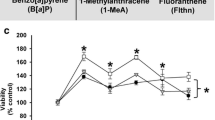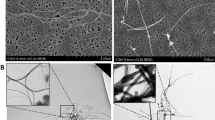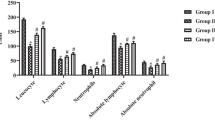Abstract
4-Ipomenaol (IPO) has been shown to induceP-450-mediated necrosis of Clara cells in experimental animals, and clinical trials were initiated to treat people with bronchioloalveolar cancers with this novel drug. We therefore performed experiments to examine two different animal lung tumor models for acute IPO cytotoxicity: hamster Clara-cell-derived adenocarcinomas and mouse alveolar type II cell tumors. Clara cells serve as stem cells for airway cell renewal and, therefore, tumors derived from Clara cells may likewise differentiate into various bronchiolar cell types, or undergo squamous cell metaplasia. Bronchiolar cell tumors were induced in Syrian hamsters by a single weekly gavage with 6.8 mgN-nitrosomethyl-n-heptylamine (NMHA)/animal for 35 weeks. NMHA-induced bronchiolar tumors were classified as well-differentiated lepidic bronchioloalveolar carcinomas, acinar adenocarcinoma, adenosquamous carcinoma, and squamous-cell carcinoma. After 35 and 46 experimental weeks, control and carcinogen-treated hamsters were injected once with doses of 40–110 mg IPO/kg i.p. and necropsied 15–48 h later. Solid and papillary tumors with alveolar cell features were induced transplacentally in C3H/HeNCr mice, by treating pregnant animals on gestation day 16 with 0.5 mmolN-nitrosoethylurea/kg, i.p. Offspring of control and carcinogen-treated mice were injected at 2–3 months of age with 35 mg or 50 mg IPO/kg i.p. and necropsied either 24–48 h or 5 and 12 days after injection. Light microscopic studies were carried out to assess cytotoxic effects in various tissues in both hamsters and mice; in hamsters, additional ultrastructural studies were performed. When administered to hamsters, IPO induced moderate to severe cytotoxicity in normal and dysplastic bronchiolar lining cells, in most lepidic bronchioloalveolar carcinomas, and in some glandular areas of adenosquamous cell carcinomas. Susceptible cells included normal, anaplastic, and neoplastic nonciliated and some ciliated bronchiolar cells. Undifferentiated and squamous tumor cells were resistant to IPO, as were resident normal alveolar type II cells. However, some adenocarcinomas composed primarily of ciliated and mucous cells also showed no IPO-induced necrosis, indicating a deficiency in appropriate activating enzymes. In the mice, IPO induced bronchiolar cell necrosis and, at the high dose, also severe pulmonary edema. No cytotoxicity was observed in normal or hyperplastic alveolar epithelium, nor in either solid or papillary growth forms of mouse alveolar cell tumors. In conclusion, these experiments show, in original tumor settings of the lung, that it is possible to achieve cell-specific cytotoxic effects based on cellular composition and functional maturity, i.e., toxicity in carcinomas of predominantly nonciliated bronchiolar cells but not in tumors of alveolar type II cell lineage.
Similar content being viewed by others
Abbreviations
- IPO:
-
4-ipomeanol
- NMHA:
-
N-nitrosomethyl-n-heptyl-amine
- APA-FCRDC:
-
Animal Production Area, Frederick Cancer Research and Development Center
References
Becci PJ, McDowell EM, Trump BF (1978) The respiratory epithelium. IV. Histogenesis of epidermoid metaplasia and carcinoma in situ in the hamster. J Natl Cancer Inst 61:577–586
Belinsky SA, Stefanski SA, Anderson MW (1993) The A/J mouse lung as a model for developing new chemointervention strategies. Cancer Res 53:410–416
Boyd MR (1976) Role of metabolic activation in the pathogenesis of chemically induced pulmonary disease: mechanism of action of the lung-toxic furan, 4-ipomeanol. Environ Health Perspect 16:127–138
Boyd MR (1977) Evidence for the Clara cell as a site of cytochromeP450-dependent mixed-function oxidase activity in lung. Nature 269:713–715
Boyd MR (1980) Biochemical mechanisms in chemical-induced lung injury: roles of metabolic activation. CRC Crit Rev Toxicol 7:103–176
Boyd MR, Burka LT, Wilson BJ (1975) Distribution, excretion, and binding of radioactivity in the rat after intraperitoneal administration of the lung-toxic furan, [14C]4-ipomeanol. Toxicol Appl Pharmacol 32:147–157
Boyd MR, Stiko A, Statham CN, Jones RB (1982) Protective role of endogenous pulmonary glutathione and other sulfhydryl compounds against lung damage by alkylating agents. Investigations with 4-ipomeanol in the rat. Biochem Pharmacol 31:1579–1583
Christian MC, Wittes RE, Leyland-Jones B, McLemore TL, Smith AC, Grieshaber CK, Chabner BA, Boyd MR (1989) 4-Ipomeanol: a novel investigational new drug for lung cancer. J Natl Cancer Inst 81:1133–1143
Czerwinski M, McLemore TL, Philpot RM, Nhamburo PT, Korzekwa K, Gelboin HV, Gonzalez FJ (1991) Metabolic activation of 4-ipomeanol by complementary DNA-expressed human cytochromesP-450: evidence for species-specific metabolism. Cancer Res 51:4636–4638
Devereux TR, Jones KG, Bend JR, Fouts JR, Statham CN, Boyd MR (1982) In vitro metabolic activation of the pulmonary toxin, 4-ipomeanol, in nonciliated bronchiolar epithelial (Clara) and alveolar type-II cells isolated from rabbit lung. J Pharmacol Exp Ther 220:223–227
Doster AR, Farrell RL, Wilson BJ (1983) An ultrastructural study of bronchiolar lesions in rats induced by 4-ipomeanol, a product from mold-damaged sweet potatoes. Am J Pathol 111:56–61
Double JA (1992) Selectivity and potency; are we doing the right things to find anti-cancer agents with these properties? Br J Cancer 65:43–144
Durham SK, Boyd MR, Castleman WL (1985) Pulmonary endothelial and bronchiolar epithelial lesions induced by 4-ipomeanol in mice. Am J Pathol 118:66–75
Dutcher JS, Boyd MR (1979) Species and strain differences in target organ alkylation and toxicity by 4-ipomeanol. Biochem Pharmacol 28:3367–3372
Evans MJ, Cabral LJ, Stephens RJ, Freeman G (1975) Transformation of alveolar type 2 cells to type 1 cells following exposure to NO2. Exp Mol Pathol 22:142–150
Evans MJ, Cabral-Anderson LJ, Freeman G (1978) Role of the Clara cell in renewal of the bronchiolar epithelium. Lab Invest 38:648–655
Falzon M, McMahon JB, Schuller HM, Boyd MR (1986) Metabolic activation and cytotoxicity of 4-ipomeanol in human non-small cell lung cancer lines. Cancer Res 46:3484–3489
Fiebig H-H, Berger DP, Winterhalter BR, Plowman J (1990) In vitro and in vivo evaluation of US-NCl compounds in human tumor xenografts. Cancer Treat Rev 17:109–117
Foley JF, Anderson MW, Stoner GD, Gaul BW, Hardisty JF, Maronpot RR (1991) Proliferative lesions of the mouse lung: progression studies in strain A mice. Exp Lung Res 17:157–168
Forkert P-G, Parkinson A, Thaete L, Malkinson A (1992) Resistance of murine lung tumors to xenobiotics-induced cytotoxicity. Cancer Res 52:6997–7003
Gram TE (1989) Pulmonary toxicity of 4-ipomeanol. Pharmacol Ther 43:291–297
Griswold DP, Harrison SD (1991) Tumor models in drug development. Cancer Metastasis Rev 10:255–261
Gunning WT, Castonguay A, Goldblatt PJ, Stoner GD (1991) Strain A/J mouse lung adenoma growth patterns vary when induced by different carcinogens. Toxicol Pathol 19:168–175
Guide for the care and use of laboratory animals (1985) NIH Publication No. 86-23, NIH, Bethesda, Md
Hallberg E (1990) Metabolism and toxicity of xenobiotics in the adrenal cortex, with particular reference to 7,12-dimethylbenz(a)anthracene. J Biochem Toxicol 5:71–90
Howard RB, Chu H, Zeligman BE, Marcell T, Bunn PA, McLemore TL, Mulvin DW, Cowen ME, Johnston MR (1991) Irradiated nude rat model for orthotopic human lung cancers. Cancer Res 51:3274–3280
Kal HB, Meijnders PJN, Van Berkel AH, Van Bekkum DW (1991) Response to chemotherapy of non-small cell bronchial rat tumours growing subcutaneously or in the lung. In Vivo 5:301–306
Kauffman SL (1981) Histogenesis of the papillary Clara cell adenoma. Am J Pathol 103:174–180
Kauffman SL, Alexander L, Sass L (1979) Histologic and ultrastructural features of the Clara cell adenoma of the mouse lung Lab Invest 40:708–716
Larsson P, Tjälve H (1988) Tracing tissues with 4-ipomeanol-metabolizing capacity in rats. Chem Biol Interact 67:1–24
Li X, Castleman WI (1990) Ultrastructural morphogenesis of 4-ipomeanol-induced bronchiolitis and interstitial pneumonia in calves. Vet Pathol 27:141–149
Lijinsky W, Kovatch RM (1988) Comparative carcinogenesis by nitrosomethylalkylamines in Syrian hamsters. Cancer Res 48:6648–6652
McDowell EM, Trump BF (1983) Histogenesis of preneoplastic and neoplastic lesions in tracheobronchial epithelium. Surv Synth Pathol Res 2:235–279
McLemore T, Coudert B, Adelberg S, Hubbard W, Czerwinski M, Green K, Mayo J, Boyd M (1988) Metabolic activation of 4-ipomeanol by human pulmonary carcinoma cells propagated in vitro and intrabronchially in nude mice. Clin Res 36:498A
McLemore TL, Litterst CL, Coudert BP, Liu MC, Hubbard WC, Adelberg S, Czerwinski M, McMahon NA, Eggleston JC, Boyd MR (1990) Metabolic activation of 4-ipomeanol in human lung, primary pulmonary carcinomas, and established human pulmonary carcinoma cell lines. J Natl Cancer Inst 82:1420–1426
Plopper CG, Macklin J, Nishio SJ, Hyde DM, Buckpitt AR (1992) Relationship of cytochromeP-450 activity to Clara cell cytotoxicity. Lab Invest 67:553–565
Rehm S, Ward JM, Ten Have-Opbroek AAW, Anderson LM, Singh G, Katyal SL, Rice JM (1988) Mouse papillary lung tumors transplacentally induced byN-nitrosoethylurea: evidence for alveolar type II cell origin by comparative light microscopic, ultrastructural, and immunohistochemical studies. Cancer Res 48:148–160
Rehm S, Devor D, Henneman JR, Ward JM (1991) Origin of spontaneous and transplacentally induced mouse lung tumors from alveolar type II cells. Exp Lung Res 17:181–195
Rehm S, Lijinsky W, Singh G, Katyal SL (1991) Mouse bronchiolar cell carcinogenesis. Histologic characterization and expression of Clara cell antigen in lesions induced byN-nitrososbis(2-chloroethyl)ureas. Am J Pathol 139:413–422
Rehm S, Lijinsky W, Thomas BJ, Kasprzak BH (1993) Clara cell antigen in normal and migratory dysplastic Clara cells, and bronchiolo-alveolar carcinoma of Syrian hamsters induced byN-nitrosomethyl-n-heptylamine. Virchows Arch [B] (in press)
Singh G, Katyal SL, Ordonez NG, Dail DH, Negishi Y, Weedn VW, Marcus PB, Weldon-Linne M, Axiotis CA, Alvarez-Fernandez E, Smith WI (1984) Type II pneumocytes in pulmonary tumors. Implications for histogenesis. Arch Pathol Lab Med 108:44–48
Singh G, Katyal SL, Ward JM, Gottron SA, Wong-Chong M-L, Riley EJ (1985) Secretory proteins of the lung in rodents: immunocytochemistry. J Histochem Cytochem 33:564–568
Smith AC, Barrett D, Stedham MA, El-hawari M, Kastello MD, Grieshaber CK, Boyd MR (1987) Preclinical toxicology studies of 4-ipomeanol: a novel candidate for clinical evaluation in lung cancer. Cancer Treat Rep 71:1157–1164
Statham CN, Boyd MR (1982) Effects of phenobarbital and 3-methylcholanthrene on the in vivo distribution, metabolism and covalent binding of 4-ipomeanol in the rat; implications for target organ toxicity. Biochem Pharmacol 31:3973–3977
Strum JM, Singh G, Katyal SL, McDowell EM (1990) Immunochemical localization of Clara cell protein by light and electron microscopy in conducting airways of fetal and neonatal hamster lung. Anat Rec 227:77–86
Thaete LG, Malkinson AM (1991) Cells of origin of primary pulmonary neoplasms in mice: morphologic and histochemical studies. Exp Lung Res 17:219–228
Ward JM, Singh G, Katyal SL, Anderson LM, Kovatch RM (1985) Immunocytochemical localization of the surfactant apoprotein and Clara cell antigen in chemically induced and naturally occurring pulmonary neoplasms of mice. Am J Pathol 118:493–499
WHO (1981) Histological typing of lung tumours (International histological classification of tumours no. 1), 2nd edn. World Health Organization, Geneva
Zeligman BE, Howard RB, Marcell T, Chu H, Rossi RP, Mulvin D, Johnston MR (1992) Chest roentgenographic techniques for demonstrating human lung tumour xenografts in nude rats. Lab Anim 26:100–106
Author information
Authors and Affiliations
Rights and permissions
About this article
Cite this article
Rehm, S., Devor, D.E. Acute effects of 4-ipomeanol on experimental lung tumors with bronchiolar or alveolar cell features in Syrian hamsters or C3H/HeNCr mice. J Cancer Res Clin Oncol 120, 41–50 (1993). https://doi.org/10.1007/BF01200723
Received:
Accepted:
Issue Date:
DOI: https://doi.org/10.1007/BF01200723




